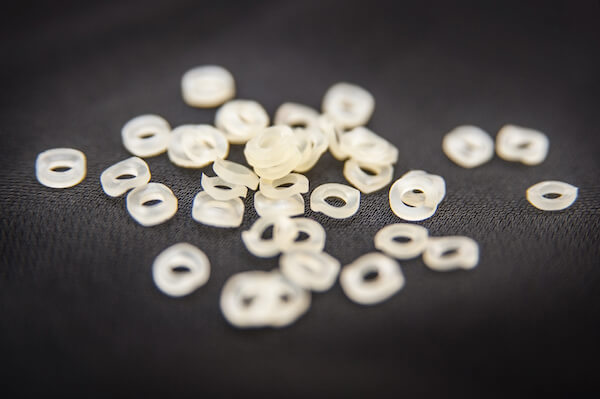
Many orthodontic patients are given a bag of rubber bands and told they have to wear them daily. This type of request may seem unusual or a bit odd, but those tiny rubber bands play a huge role in helping you to improve your smile. Discover why orthodontists use rubber bands as part of your treatment and learn some tips that will help you adjust to wearing rubber bands.
The Two Types of Orthodontic Rubber Bands
Orthodontists use two different types of rubber bands to help shift and move your teeth into proper alignment. Every orthodontic patient will have at least one type of rubber band – ligatures – as their treatment, while not everyone will need the second type of rubber bands – interarch rubber bands – as part of their treatment.
Ligatures are tiny little rubber bands that are used by every orthodontic patient who gets traditional braces. These small rubber bands are wrapped around each of the brackets that are placed on your teeth. Their purpose is to hold the archwire in place during your treatment.
Ligatures are the fun part of having braces. They come in a variety of colors which allows patients to customize how their braces look. Some patients love picking out different colors during each of their appointments while others prefer the clear rubber bands that have a more natural look.
The second type of rubber bands, interarch rubber bands or elastics, are a common part of orthodontic treatment, but not everyone will need this treatment. These are larger than ligatures and are placed on both sides of your mouth.
The purpose of the interarch rubber bands is to help adjust your bite. The rubber bands provide enough tension that your jaw will subtly and slowly shift forwards or backwards. Over time, the jaw movement will give you a properly aligned jaw and completely fix your bite.
How are Interarch Rubber Bands Worn?
Unlike ligature rubber bands that only can be removed by your orthodontist, interarch rubber bands will need to be replaced on a daily basis. This means you must learn how to properly hook them up to your braces.
The following is a brief look at how you attach the rubber bands:
- Rubber bands are worn on each side of your mouth
- Top of the rubber band is hooked on a bracket that has been attached to one of your canines or one of your molars
- Rubberband is stretched and then hooked on the bracket that is on a bottom molar or on a bottom canine
- Sometimes rubber bands are worn as triangles or boxes or in the center of your mouth to align your front teeth also.
Dr. Valderrama will show you how to properly remove and replace the interarch rubber bands. If you should encounter any problems, you can always call the staff at our Valderrama Orthodontic’s office who will gladly answer any questions you may have or walk you through how to replace the rubber bands.
Tips for Adjusting to Wearing Rubber Bands with Braces
Wearing stretchy, rubbery material in your mouth is a completely new experience. There will be a period of adjustment as you get used to how the rubber bands feel, the subtle pain they may cause, and the new routine you will have to do on a daily basis.
Orthodontic patients have found the following tips useful in helping with the adjustment period:
- Use a mirror the first few times you replace interarch rubber bands
- Be patient. It will take a while to learn how to hook the rubber bands in your mouth. If you still find it difficult, your orthodontist may be able to give you bigger rubber bands. However, they often like to keep the rubber bands as small as possible as that helps create the tension needed to move the jaw.
- Always keep the rubber bands close by as you never know if they may break
- Change the rubber bands daily at the same time. This will help it become a part of your daily routine.
- Make sure you remove the rubber bands before you brush your teeth or whenever you want to eat something – even if it is a small snack
- Rinse your mouth with warm salt water if you feel any pain or discomfort
Have any other questions about rubber bands or want to learn more about orthodontic treatment options then call Valderrama Orthodontics. Our office staff will gladly answer any questions you may have or schedule an appointment so you can speak with our orthodontist Dr. Natalia Valderrama at 321.425.5050.


Let's Get Social